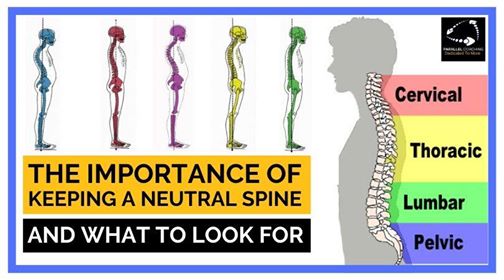What is the importance of a neutral spine, and what should you be looking for as a FitPro?
Whether you are newly qualified or training to be a PT, the term “neutral spine” gets used a lot. You get asked it in your Level 3 PT LAP, you get told to say it as a teaching point when instructing… but what does it really mean?
In this blog, you’ll learn all about a neutral spine, and how to look for this and postural compensations with your clients
What is a Neutral Spine?
First up, what is a neutral spine?
Our spine has 5 sections and these sections each have natural curves to them. A neutral spine maintains these slight curves, without distortion.
The spine comprises of:
- Cervical – 7 vertebrae, concave curve of 20-40 degrees
- Thoracic – 12 vertebrae, convex curve of approximately 20-40 degrees
- Lumbar – 5 vertebrae, concave curve of 30-50 degrees
- Sacrum – 5 fused vertebrae, slightly convex
- Coccyx – 3 fused vertebrae, slightly concave
You can see these natural curves in the sagittal plane when viewed from the side of the client. This is when the ear, shoulder, mid-hip, knee and ankle bone are all in alignment.
When viewing the client from the side you should be able to draw a straight line through all of these features.
There are no natural curves in the frontal plane, so when you look at your client’s posture from the back or front, any distortion would be considered a postural distortion like scoliosis.
Importance of a Neutral Spine
It is important to maintain a neutral spine for many reasons:
- the natural curves help cushion and protect the spine.
- it is the optimal way to attain balance and proportion.
- it allows for the most efficient movement patterns.
- it places the least amount of stress on ligaments, muscles, tendons and joints.
It is especially important to correct your client’s posture during movement because:
- Work the correct muscles
- Avoid stress and injury on ligaments and tendons
- Encourage full core engagement
- Engage more stabilising muscles
- Move ergonomically as the exercise was intended
- Increase neuromuscular pathways and awareness of posture
- Reduce the risk of developing postural distortions
- Comfort and reduced back pain
The video below shows the difference between a neutral spine and an exaggerated lumbar curve during a suspension chest press. Notice that the correct neutral-spine allows for greater activation of the prime mover, in this case, the Pectoralis Major
What to look for in your clients?
When your client is doing any exercise,
FIRST, make sure they start in a neutral position, so the straight line from ears, shoulders, hips knees and ankles. And that they have feet shoulder-width apart.
THEN, during the exercise look at which joint is moving, is it caused by the prime mover or synergist?
If not, and instead it is the spine, like in the video below
then you need to correct the client back to a neutral spine to get the best out of the exercise.
How to Correct to a neutral spine?
Stop the exercise and return to passive posture (standing still), asking the client to keep the core and glutes engaged.
Use imagery and external cues to progress client performance.
Experiment with finding the best external cues for your client and for the exercise they are doing. This means they can think of something outside of their body and improve performance.
You could use external cues like:
- Keeping the body as straight as a pencil from head to toe
- Extend the heart to the sky
- Imagine there’s a £50 note between your butt cheeks.
The crux analyzing your client’s spine alignment is to use the Squat Analysis
The squat analysis protocol shows you how to observe your client from all angles, and WHAT to look for… just like a human x-ray machine
You can use the grid to “tick” each postural compensation you can see whilst your client is doing an overhead squat
Then using this data you can use the formula to understand exactly which muscles are tight and weak in the body.
This gives structure and purpose to your planning, meaning that planning a client session is no-longer left to guesswork.
You can now access our Squat Analysis Protocol and Analysis as one of 34 documents that can be downloaded directly from our FitPro Start Up Kit.
All The Documents & Forms You Need To Set Up & Start Training Clients Immediately (Without The Hassle Of Creating Them From Scratch):
https://revision.parallelcoaching.co.uk/fitpro-start-up-kit-details

Dedicated to More
Hayley “neutral spine” Bergman
Parallel Coaching
You can also find us on the following platforms:
Instagram: https://www.instagram.com/parallelcoaching
Facebook: https://www.facebook.com/ParallelCoaching
Twitter: https://twitter.com/ParallelCoach
YouTube Channel: http://bit.ly/2F1Z1bs

